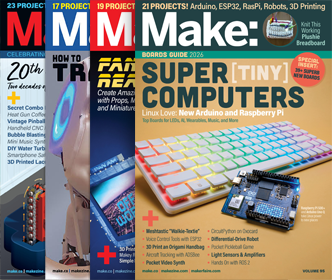Electric Cinderella
![Buildingillusions3[1]](http://cdn.makezine.com/make/blogs/blog.makezine.com/buildingillusions3%5B1%5D.jpg) Drawing from the myth of Cinderella a pair of elegant sexy shoes with a crystal tip but with a new power inside: a stun gun. It’s just a shielded, potential weapon, meant to be used only once, as the wearer has to break the glass to use it. Cinderella is no more without defenses; waiting for the prince to save or worse to chose her [via] Link.
Drawing from the myth of Cinderella a pair of elegant sexy shoes with a crystal tip but with a new power inside: a stun gun. It’s just a shielded, potential weapon, meant to be used only once, as the wearer has to break the glass to use it. Cinderella is no more without defenses; waiting for the prince to save or worse to chose her [via] Link.



 Some DIY versions on the way I bet…Eastman Industries has taken the lawn mower to a new level (literally). The HoverMower is designed to hover slightly above the ground on a cushion of air, making it more maneuverable, extremely light, easy to propel and able to reach previously inaccessible places like extreme inclines, wet grounds, and tight, difficult to get at places. [
Some DIY versions on the way I bet…Eastman Industries has taken the lawn mower to a new level (literally). The HoverMower is designed to hover slightly above the ground on a cushion of air, making it more maneuverable, extremely light, easy to propel and able to reach previously inaccessible places like extreme inclines, wet grounds, and tight, difficult to get at places. [


 The Corporate fallout Detector scans barcodes off of consumer products, and makes a clicking noise based on the environmental or ethical record (selectable via the “sensitivity” switch) of the manufacturer. It explores issues of corporate accountability and individual choice. Due to increasingly complex global supply chains, a single product we buy may contain parts made by various companies all over the world.
The Corporate fallout Detector scans barcodes off of consumer products, and makes a clicking noise based on the environmental or ethical record (selectable via the “sensitivity” switch) of the manufacturer. It explores issues of corporate accountability and individual choice. Due to increasingly complex global supply chains, a single product we buy may contain parts made by various companies all over the world. 
 Review of the $20 RFID mouse- Designed with A4Tech’s Innovative Radio Frequency Identification Technology. This Battery-Free Wireless Optical Mouse is absolutely Interference-free from any wireless frequency. In addition to that, the RFID Mouse Pad is directly power activated & the mouse creates huge cost saving for its users. Most importantly, this technology avoids unnecessary pollution caused by batteries. [
Review of the $20 RFID mouse- Designed with A4Tech’s Innovative Radio Frequency Identification Technology. This Battery-Free Wireless Optical Mouse is absolutely Interference-free from any wireless frequency. In addition to that, the RFID Mouse Pad is directly power activated & the mouse creates huge cost saving for its users. Most importantly, this technology avoids unnecessary pollution caused by batteries. [
 Sensors embedded in a glove monitor the heart and hand sweat glands of a sleeping person to record emotional arousals provoked by the brain during dreaming periods. The resulting records – hypnograms – are 3D drawings that the user may learn to interpret and use as introspection tools over time. [
Sensors embedded in a glove monitor the heart and hand sweat glands of a sleeping person to record emotional arousals provoked by the brain during dreaming periods. The resulting records – hypnograms – are 3D drawings that the user may learn to interpret and use as introspection tools over time. [
 Longtailer Chris Anderson posts up about using some tools to create a rocket launcher from your favorite video game. 1. Capture a scene from your favorite videogame (HijackGL). 2. Import it into a CAD program and isolate an object you’d like to have. 3. Send it to a fabricator, either a 3D printer or a computer-controlled milling machine, and watch it emerge as a physical object. We’re still a few years away from doing this easily- but home fabricating isn’t that far away at all…
Longtailer Chris Anderson posts up about using some tools to create a rocket launcher from your favorite video game. 1. Capture a scene from your favorite videogame (HijackGL). 2. Import it into a CAD program and isolate an object you’d like to have. 3. Send it to a fabricator, either a 3D printer or a computer-controlled milling machine, and watch it emerge as a physical object. We’re still a few years away from doing this easily- but home fabricating isn’t that far away at all…